The need to understand the mechanics of conduct of ‘Deep Operations’ is paramount while undertaking offensive operations. “Limited War” and “Limited Objectives” are mindsets of the mediocre who have not grasped the essence of Major Staff Duties which is to be innovative, gather momentum and be unpredictable after operations commence and not get tied down in predictive methodologies. No War is ever fought and won with adequate resources. However, the fact that India’s Eastern Army Command went to war without possessing an Independent Armoured Brigade and an Independent Amphibious Brigade in its ORBAT stood out as glaring failings. The purpose of doing such an ‘unsparing’ study of the Bangladesh War operations is to drive home the point that if we have to fight the next War, our higher commanders should not be found wanting in the skills needed to undertake ‘Deep Operations’.
The Operation to liberate Bangladesh in 1971 was an acid test as to how a war should be fought to its logical conclusion. The Indian Armed Forces in Eastern Command came out victorious in a matter of two weeks despite having a determined and well-prepared opponent who had six months time to prepare, augment their defences and fine tune their War Plans. The Pakistanis had inducted a total of 42 Infantry Battalions with four Divisional HQs into the Eastern Theatre, besides 15,000 additional personnel of Paramilitary Border Guarding Wings. In retrospect, one can say that the Pakistanis paid the price for being supremely overconfident that India was in no position to launch an all-out liberation war. Since March 1971, the Pak military had done all the right things to deeply antagonise the Bengali population. They behaved like an unaccountable “occupation force” indulging in barbarities unworthy of men in uniform. Their aim was not only to crush the mass-based Awami League which had won the elections, but also to drive out the large minority Hindu population in East Pakistan into India so as to create a serious economic and social burden for us. It was their bad luck that the Indian Army had matured and possessed some senior officers who had mastery over the nuances of fighting ‘Deep Operations’.
Deep Operations is a concept of offensive operations developed by the Soviet Red Army commanders led by Michail Tukachevski in the mid-1930s, which was put into effect in the successful Soviet large scale offensives after the Kursk mega-battle, starting with the liberation of Kharkiev in the Ukraine in September 1943. The ‘Deep Operations’ concept involves employment of multiple echelons (called Developmental Echelons, Strike Echelons and Mobile Groups), orchestrated to tie down the Enemy’s Defensive Battle layout and create opportunities for bypassing them and take the battle into the enemy’s vulnerable depth area and thereafter, concentrate on reducing the enemy’s “Final Objective” in a much earlier timeframe.
The Indian Army was the decisive instrument which undid the divisive Two Nation Theory in the subcontinent, which had pitted brother against brother during partition based on religious identities and which led to the mass transfer of innocent populations, because of a dangerous idea which had caught the imagination of the misled masses.
Conduct of Operations
Tasking of Indian 2 Corps
9 Infantry Division and 4 Mountain Division were to capture Jessore, Kushtia, Khulna and then Faridpur (major ferry site on the River Padma). Thereafter, bounce to Dacca, if opportunity permitted. Before the outbreak of full-fledged war on December 03 – 04, 1971:
• By November 29, ‘9 Infantry Div’ had carried out preliminary operations and reached up to Arpana on the Chaugacha – Jessore Axis. River Bhairab was bridged to open up the Axis.
• 4 Mountain Division had captured Jiban-nagar, Uthali, Darsana and contacted Khalispur on the Axis towards Kotchandpur. It had also advanced up to Silinda towards Kotchandpur.
Indian 2 Corps was the strongest grouping in Eastern Command to make a “Go for Dacca!”. After the outbreak of War, 9 Infantry Div pressed on its attacks towards Jessore using 42 and 350 Infantry Brigades. Jessore was a designated Fortress and Cantonment town assigned to be defended by Pakistan’s 107 Infantry Brigade. As there were also reports of a massive Para drop (dummy), East of Jessore, Cdr 107 Pak Brigade (Brig Malik Hayat Khan) panicked and asked permission from General Niazi to withdraw South towards Khulna as his 9 Div Cdr (Maj Gen M H Ansari) had moved to Faridpur to set up his Tac HQ there and was out of communication.
On December 06, General Niazi gave the permission to abandon Jessore as he wanted the Brigade Group of 4 x Battalions to be extricated intact for later battles. Indian 32 Infantry Brigade captured Jessore on December 07. The early fall of the important Pak fortress of Jessore electrified the whole of Indian Eastern Command to persist with their offensives and at the same time, had the opposite effect of demoralising the other Pak garrisons in East Pakistan who were fighting stubbornly so far. Unfortunately, Indian 2 Corps did not exploit the momentum of this great success and push on in a concerted manner towards the ‘Deep Objectives’ of Faridpur Crossing and Golundo Ghat Ferry on the River Padma, by concentrating on reducing Magura next and seizing bridge-heads on the Rivers Garai and Madhumati thereafter. This was a strategic error of the first magnitude, as 2 Corps had the best chances of closing on to Dacca first! As per plans made before the War, 9 Indian Infantry Division followed Pak 107 Infantry Brigade to the South towards Khulna, instead of masking it with a Brigade. 107 Infantry Brigade fought successive delaying battles till the end of the War and tied down the Indian 9 Infantry Division.
In Indian 4 Mountain Division sector of operations, 41 Mountain Brigade tasked a Battalion Group with armour to establish a block between Chuadanga and Jhenida. This prevented two Pakistani Battalions from falling back on Jhenida and they instead moved North to Kushtia along with the Pakistani 57 Infantry Brigade Commander (Brig Manzoor Ahmed) who had got separated from his HQ at Jhenida. 41 Infantry Brigade advanced along a subsidiary track towards Jhenida and captured it by December 07. 4 Mountain Division thereafter captured Maghura by December 09, by launching 62 Mountain Brigade. Indian 2 Corps was thus ideally poised to undertake ‘Deep Operations’ and capture Gualando Ghat ferry next, but at this crucial stage another tactical blunder was committed! 7 Mountain Brigade (-) of 4 Mountain Division which had been tasked to capture Kushtia in the North, met with stiff opposition including Pakistani armour on December 09. Over the next few days, 4 Mountain Division forgot about its ‘Deep Objectives’ and diverted 41 Mountain Brigade and 62 Infantry Brigade to reduce Kushtia. All areas up to the Hardinge Bridge on the Padma were cleared by December 12. Pak 57 Infantry Brigade blew up this bridge and made a successful exit to Pakistani 16 Infantry Division sector in the North West. This momentous mistake enabled the Pakis to move reinforcements from Dacca and strengthen the lightly held Madhumati River defence line. A great opportunity to progress operations on the Main Thrust Line towards the Dacca Ferry crossings was thus lost. 4 Mountain Div could resume the offensive towards Faridpur only on December 15, with 62 and 7 Mountain Brigades.
The following Flow Chart gives the possible ‘Course of Operations’ in Indian 2 Corps zone, had the concept of Deep Operations been applied by its commanders by tasking a Brigade of 9 Infantry Div to mask Pak 107 Infantry Brigade and another Brigade of 4 Mountain Div to mask Pak 57 Infantry Brigade and progress operations continuously towards the Dacca ferries with the bulk of the Corps’ combat potential:
In the final analysis, strategic judgement was not exercised during the course of evolving battle scenarios and initial success was not exploited to threaten the enemy’s ‘nerve centre’ in an efficient time frame, due to blind adherence to following an ‘attrition strategy’ and chasing the enemy wherever they led the attacker.
- Secure the Siliguri Corridor by pushing back the Pak deployments existing North of the Thakurgaon – Lalmanirhat line.
- Cut the Hilli – Gaibanda ‘waistline’ thereby dividing Pakistani 16 Infantry Div deployment.
- Secure maximum territory including Bogra and important Border towns.
During Preliminary Operations starting from November 21, 1971:
- 9 Mountain Brigade/6 Mountain Div (Army HQ Reserve for Bhutan), assisted 33 Corps by clearing the ‘Teesta Pocket’ by December 08, 1971, and posing a threat to Rangpur.
- 71 Mountain Brigade advanced up to River Atrai and River Dhap, North of Dinajpur.
- 66 Mountain Brigade/20 Mountain Div cleared Phulbari-Charkai-Nawabganj and established a bridgehead across Karatoya River by December 06, evicting Pakistani 26 FF. Due to these developments General Niazi sacked the Pakistani 23 Infantry Brigade Commander.
- 202 Mountain Brigade/20 Mountain Div was held up West of Hilli Complex by Pak 4 FF Grouping.
- 165 Mountain Brigade/20 Mountain Div provided the Firm Base in the Balurghat Bulge for the above mentioned operations.
- 20 Mountain Div again launched 202 Mountain Div onto Hilli Complex. It was cleared of Pakistani 4 FF by December 11, which had put up a heroic defence for over two weeks. 66 Brigade assisted 202 Brigade by clearing Bhaduria, NE of Hilli by December 11, overcoming very stiff resistance. 66 Brigade further exploited up to Khetlal by December 13.
- 340 (I) Mountain Brigade Group which was located South of Dinajpur as Corps Reserve, was released to 20 Mountain Div on December 06, to speed up the operations. It followed 66 Mountain Brigade advance and cut the Rangpur-Pirganj road on December 07. 2/5 GR along with a squadron of 69 Armoured Regiment ambushed the convoy in which Pakistani 16 Div GOC and 205 Brigade Commander were travelling, but they escaped with injuries. 2/5 GR also beat back fierce counterattacks launched by Pakistani 205 Infantry Brigade, in which the CO of 32 BALUCH got killed. By December 09, 340 Brigade succeeded in severing Pakistani 16 Div Sector by advancing up to Sadullahpur. Palashbari, which was to the South of Pirganj, Gaibanda and Phulchari Ghat Ferry were also captured by 66 Mountain Brigade on December 09.
It was at this time that HQ Eastern Command and 33 Corps did not seize the opportunity of this breakthrough, by pushing across a ‘Battalion Group’ including an Armour Squadron and Company Engineers across the wide River Jamuna from Phulchari Ghat Ferry by December 10, to join the ‘race for Dacca’ from the Northern Sector through an unexpected thrust line, which was bereft of any worthwhile opposition.
- 340 Brigade cleared the Pakistani gun positions East of Hilli and captured Ghoraghat by December 12. All offensive actions of 20 Mountain Div were ably supported by the tanks of 69 Armoured Regiment (PT-76), 63 CAV (T-55) and 20 MARATHA LI (Mech).
- 20 Mountain Div then concentrated its attention South towards Bogra, and crossing of Rivers Ichamati, Sibga and Karatoya in the path. 5/11 GR of 340 Brigade supported by tanks raced South to seize the bridge over the River Karatoya intact at Mahasthan, and also overran the 32 BALUCH deployment North of Bogra by December 13. A battle group of 69 Armoured Regiment and 6 GUARDS then bypassed Bogra and established Blocks to its South by December 14. 340 Brigade then attacked Bogra and overran the Tac HQ of Pakistani 16 Infantry Div. All Pakistani resistance was eliminated by December 16 and HQ Pakistani 205 Infantry Brigade with its Commander was captured.
- On December 15, GOC 20 Mountain Div ordered 66 and 202 Mountain Brigades to switch North from the South of Pirganj area, and reduce Rangpur. Rangpur fell to 66 Mountain Brigade on December 16 (AN) including the Tac HQ of Pakisani 34 Infantry Brigade with its Commander, who had been moved up there.
- In the Dinajpur Sector, Indian 71 Mountain Brigade resumed the offensive on December 11, made a successful crossing of River Atrai at Khansama on December 13 against determined opposition and further cleared Darwani, Dangapara and Nilphamari. On December 17, Pakistani 23 Infantry Brigade Commander surrendered at Saidpur.
Analysis of Indian 33 Corps Zone – Operations
33 Corps conducted its operations very effectively against a determined and well-entrenched opponent. Relative strength was only marginally in its favour. Ably supported by armour and a Mechanised Infantry battalion, 20 Div succeeded in bisecting Pakistani 16 Infantry Div deployment on the Hilli – Gaibanda waistline by December 10. Its 340 Brigade overwhelmed Bogra by December 15.
The removal of HQ 3 (I) Armoured Brigade and 63 CAV (-2) from the Eastern Theatre on December 11 by Army HQs (due to the setbacks in Chhamb) when offensive operations were in full swing, was a faulty knee-jerk reaction, which benefitted neither the Eastern Front nor the Western Front. 20 Div could have tasked 202 Brigade on December 12, for the ‘Deep Operations’ task of seizure of the vital Sirajganj Ferry on River Jamuna, South of Bogra leading to Dacca. Its shifting to the North across terrain with very poor communications involving two days of march without artillery and support elements catching up, was due to the Army HQ’s ‘instructions’ of December 13 to consolidate maximum captured territory in the East for the establishment of the interim Bangladesh government, should a UN Security Council-sponsored ‘ceasefire’ come into effect over the next two to three days.
Alternatively, the better ‘Attack Plan’ for 33 Corps would have been:
- Deploy 340 (I) Infantry Brigade in Balurghat Bulge and task it to later progress the operations launched by 66 Mountain Brigade North of Hilli as actually executed.
- 20 Mountain Div with 202 and 165 Mountain Brigades to attack from Gajol-Nischitapur area on the Patnitola-Mahadebpur – Naogaon-Sherpur-Sirajgang Axis.
This would have given 33 Corps the chance to undertake the game-changing ‘Deep Operations’ option more speedily and over more suitable terrain, where the enemy deployment was in lesser strength. The ‘obvious’ attack axis which was selected from the Balurghat Bulge, i.e. onto Hilli-Goraghat-Gaibanda should have been best avoided as the enemy deployment and state of defences were better which considerably delayed progress of operations and enhanced casualties. However, HQ Eastern Command had not given either support or encouragement for such a Plan, which would have posed the biggest to the final Theatre Objective of Dacca from this sector of operations.
The destruction of the Phulchari Ghat Ferry by the IAF and ground troops was also unwarranted and short-sighted, as this precluded the option of switching over of a Brigade Group of 33 Corps across River Jamuna to join the “Race for Dacca”.
To cover this 185-km frontage sector extending from the Eastern Bank of the River Jamuna to the Western border of the mountainous Sylhet District and starting from the plains immediately South of the Khasi and Jaintia Hills on the Indian side; though the terrain had very few natural obstacles before reaching Dacca 160 km away, the Indian allocation of forces seemed to have been an afterthought! Considering the fact that the Pakistani deployment here was also light and they possessed no armour except in the Dacca area, this points to a serious ‘mistake’ by the Indian Army’s Military Operations Directorate and the HQ Eastern Army Command’s General Staff Branch. It is so obvious that the ‘Terrain Analysis’ and the ‘Intelligence Appreciation’ from the enemy’s perspective about the possible outcome of operations in this sector had not been properly done, as borne out by the actual course of operations. Ideally, the Indian Army should have assigned the following Groupings to this sector:
- 1 x Mountain Division (-) – Preferably 27 Mountain Division.
- 1 x (I) Infantry Brigade (-) – Possibly 50(I) Para Brigade Group.
- 1 x (I) Squadron Armour.
- 1 x (I) Composite Mechanised Reconnaissance Squadron.
Conduct of Operations
‘95 Mountain Brigade’ cleared the Pakistani Kamalpur Border Strongpoint on December 04, and reached the Brahmaputra River by December 07. This river was crossed on December 08 and Blocks established South of the Pakistani Jamalpur fortress. Two other infantry battalions were subsequently built up across the river and attacks launched on December 10. The Pakistani 93 Infantry Brigade which was putting up a stubborn fight at Jamalpur and Mymensingh was suddenly ordered by General Niazi on December 10 to withdraw and reinforce Dacca, following Indian heli-borne landings at Raipur/ Narsingdi and reports of in the international media that a major Indian para-drop operation near Dacca was in the offing. The para-drop of an Indian Battalion Group actually occurred near the Poongli Bridge short of Tangail on the evening of December 11. They successfully blocked the withdrawal of Pakistani 93 Infantry Brigade rear elements to Dacca.
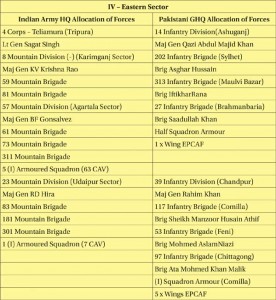 Similarly, a Battalion from FJ Sector advancing on Haluaghat-Mymensingh axis seized Mymensingh fortress on December 11 and linked up with Indian 93 Mountain Brigade forward elements at Madhupur on December 12. Thereafter, 6 SIKHLI (ex 167 Mountain Brigade/5 Mountain Div), which had been released by Army HQs and had reached the operational area, was also placed under 93 Mountain Brigade. It captured Kaliakhar on December 13 and also took the Pakistani Brigade Commander captive near Dhamrai. It further advanced up to Joydebpur on December 15. 167 Infantry Brigade arrived and built up there by December 16, for the assault on Dacca. 13 GUARDS (of 95 Mountain Brigade) was placed under command of FJ Sector on December 13 and it cleared Sabhar by December 15. 2 PARA was also placed under FJ Sector on December 13 and they closed in on the Mirpur Bridge on River Turag on the outskirts of Dacca by December 15.
Similarly, a Battalion from FJ Sector advancing on Haluaghat-Mymensingh axis seized Mymensingh fortress on December 11 and linked up with Indian 93 Mountain Brigade forward elements at Madhupur on December 12. Thereafter, 6 SIKHLI (ex 167 Mountain Brigade/5 Mountain Div), which had been released by Army HQs and had reached the operational area, was also placed under 93 Mountain Brigade. It captured Kaliakhar on December 13 and also took the Pakistani Brigade Commander captive near Dhamrai. It further advanced up to Joydebpur on December 15. 167 Infantry Brigade arrived and built up there by December 16, for the assault on Dacca. 13 GUARDS (of 95 Mountain Brigade) was placed under command of FJ Sector on December 13 and it cleared Sabhar by December 15. 2 PARA was also placed under FJ Sector on December 13 and they closed in on the Mirpur Bridge on River Turag on the outskirts of Dacca by December 15.
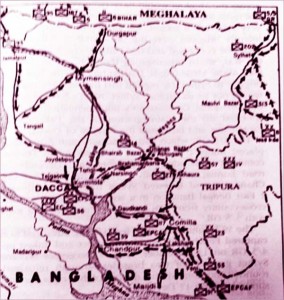 To coordinate the assault on Dacca, Army HQs placed 101 Communication Zone under the command of HQ 4 Corps on December 15. After the surrender of the Pakistani forces was agreed to by General Niazi, 4 PARA was the first Indian combat unit to enter Dacca and oversee the ‘unconditional surrender’ ceremony at the Ramna Racecourse at 1655 hours IST on December 16.
To coordinate the assault on Dacca, Army HQs placed 101 Communication Zone under the command of HQ 4 Corps on December 15. After the surrender of the Pakistani forces was agreed to by General Niazi, 4 PARA was the first Indian combat unit to enter Dacca and oversee the ‘unconditional surrender’ ceremony at the Ramna Racecourse at 1655 hours IST on December 16.
Tasks Assigned to GOC Indian 4 Corps
- Make rapid advances up to River Meghna and seize the ports of Chandpur, Daudkandi and the ferry at Sherpur and Sadipur on River Surma towards Sylhet.
- Occupy Brahmanbaria, Sylhet, Comilla, Chandpur and push towards Chittagong.
Progress of Operations
8 Mountain Div. was tasked to capture Maulvi Bazar, reduce Sylhet and thereafter progress operations towards Brahmanbaria. 81 Mountain Brigade captured Maulvi Bazar on December 09, 1971 and evicted Pak 313 Infantry Brigade which was forced to pull back. It then pursued the Pakistanis across River Kusiyara seizing the Sadipur/Sherpur Ferry and reached the outskirts of Sylhet from the South. General Niazi’s plan was for 313 Infantry Brigade to carry out a tactical withdrawal towards Dacca but both the GOC Pakistani 14 Div and 313 Infantry Brigade Commander opposed this proposal as impractical and did not comply. They were removed from command.
Indian 59 Mountain Brigade had captured Kalaura strongpoint to the North of Sylhet by December 07. Based on wireless intercepts that the Pakistani GHQ had ordered the Sylhet Garrison to fall back on Brahmanbaria, 4/5 GR was airlifted to the area SE of Sylhet across River Surma on the morning of December 08. They established a firm base there. 59 Mountain Brigade which had been pulled South as Corps Reserve, was again released back to 8 Mountain Div on December 10, and they resumed the attack onto Sylhet from the SE direction. Linkup was achieved with 4/5 GR by December 14. The Sylhet Garrison consisting of 6,500 Pakistani troops including three Brigadiers surrendered to Major General Krishna Rao on December 16. The BSF played a gallant role in these operations.
57 Mountain Div.: In this sector, Akhaura was held by 12 FF/27 Pakistani Brigade. It was captured by 18 RAJPUT/311 Mountain Brigade by the morning of December 04 after an epic fight. 73 Mountain Brigade was tasked to capture Brahmanbaria, while 311 Mountain Brigade secured the road leading to Brahmanbaria from the South. 73 Mountain Brigade seized Brahmanbaria on December 07. The next objective for 57 Mountain Div was Ashuganj on the Eastern bank of River Meghna, near the Coronation Rail Bridge leading to Bhairab Bazar on the West of River Meghna. On the morning of December 09, the Pakistani HQ 14 Infantry Div withdrew to Bhairab Bazar and blew up the Rail Bridge on the Meghna, leaving Pakistani 27 Brigade stranded on the Eastern side. This incensed General Niazi and he sacked the Div. Commander. 311 Mountain Brigade mounted a fierce attack on Ashuganj on December 09 with 18 RAJPUT and 10 BIHAR, which was beaten back by Pakistani 27 Brigade with 33 BALUCH and 12 FF. Thereafter, during the night of December 09-10, Pakistani 27 Brigade successfully crossed over to Bhairab Bazar side using country boats. Ashuganj was occupied by 311 Mountain Brigade on December 10.
23 Mountain Division had concentrated in South Tripura and in preliminary operations, cleared the Belonia Bulge by December 02. Facing it was Pakistani 39 Infantry Div, with 117 Infantry Brigade in the Comilla Sector and 53 Infantry Brigade in the Laksham Sector. The clearance of the Belonia Bulge created a false impression in the Pakistani commanders’ minds that the Indians would seize Feni next. So they moved the bulk of Pakistani 53 Brigade from the Laksham Sector towards Feni on December 03-04. When these reports reached Lt Gen Sagat Singh, he decided to seize the opportunity and make a dash towards the river port of Chandpur through the gap between the Pakistani deployment at Lalmai and Laksham. He, therefore, changed his plans, as follows:
• 61 Mountain Brigade (Corps Reserve ex 57 Mountain Div) along with a squadron of tanks was allotted to 23 Mountain Div and was tasked to contain the Pakistani deployment in the Lalmai Heights and Mynamati Cantt (West of Comilla) area.
• 83 Mountain Brigade was tasked to protect the Southern flank of 23 Div operations and cut the Laksham-Feni road.
• 301 Mountain Brigade was tasked to advance through the gap between Comilla and Lalmai along with 1 (I) Armoured Squadron, and make a dash towards Chandpur Ferry (also the location of Pakistani 39 Infantry Div HQ).
• 181 Mountain Brigade was tasked to reduce Laksham.
By December 05, 61 Mountain Brigade had penetrated North of Comilla and cut the road to Dacca. Thereafter, it built up North and West of Mynamati Cantt along with armour. This forced Brigadier Atif to pull back his 117 Infantry Brigade from Comilla and Lalmai Heights to the fortress of Mynamati, where they remained bottled-up till the end of the War. Comilla fell to 61 Mountain Brigade on December 09. 61 Mountain Brigade quickly exploited this and sent 12 KUMAON Battalion Group towards the Meghna River and seized the vital Daudkandi Ferry on December 09. This was a masterstroke.
39 BALUCH/53 Pakistani Infantry Brigade panicked and withdrew from Laksham to Mynamati on December 08. There it remained bottled up. This action had a cascading effect and 25 FF/Pak 117 Infantry Brigade which was deployed in the Lalmai Heights area (after being attacked by 301 Mountain Brigade) also fell back and surrendered to 61 Mountain Brigade at Comilla on December 12 after it failed to reach Mynamati.
On December 10, 181 Mountain Brigade captured Laksham. Thereafter, it joined the attack on Mynamati fortress from the South, till the Pakistani garrison surrendered on December 16. After the eviction of Pakistani 53 Infantry Brigade from Laksham area, 83 Mountain Brigade was ordered to progress operations towards Chittagong. It was assisted by the ad hoc ‘Kilo Force’ Grouping consisting of Indian Army, East Bengal Regiment Battalions and Mukti Bahini columns. The Pakistani Garrison at Chittagong surrendered on December 17.
301 Mountain Brigade carried out the deadliest operation of the War. At the onset of the War, the Brigade cleared Mian Bazar, South of Comilla. 25 FF was thereafter wiped out in the Lalmai Heights area and its CO captured. On December 08, 301 Brigade captured Comilla airfield and cleared the town after bitter fighting. Thereafter, it raced towards Chandpur River Port and smashed the HQ of Pakistani 39 Infantry Division on December 09. This action made General Niazi lose his nerve, as he was barely able to evacuate the Divisional Commander by a steamer. The GOC got injured in an airstrike and was later sent out of East Pakistan by helicopter to Burma. The striking success of Indian 4 Corps in reaching River Meghna at Ashuganj, Daudkandi and Chandpur by December 09, in spite of stiff opposition and bad terrain, electrified Eastern Command and caused an irretrievable dip in Pakistani morale.
Operations across the Meghna River
Sensing the uncertainty that gripped the Pakistani forces, Lt Gen Sagat Singh heli-lifted 4 GUARDS/311 Mountain Brigade/57 Mountain Div along with a Light Troop of artillery to ‘Raipura’ across River Meghna, about ten kilometres South of Bhairab Bazar on December 09 itself. They moved ten kilometres further South unopposed and established a Firm Base near ‘Narsingdi’ on December 10. 73 Mountain Brigade/57 Mountain Div started crossing River Meghna in country boats South of Bhairab Bazar on December 09 and contained Pakistani deployment there.
311 Mountain Brigade including a major part of its supporting artillery completed its build up in Narsingdi area by December 11, both by heli-lift and by country boats to cross River Meghna. Narsingdi was overrun on December 12 and both the rail and road bridges there were captured intact. On December 13, the rail bridge over the Lakhya River connecting to Tungi was captured and 73 Mountain Brigade advanced further. By the evening of December 14, 65 Mountain Regiment under 311 Mountain Brigade had moved up its guns and had started pounding targets located in the heart of Dacca Cantt.
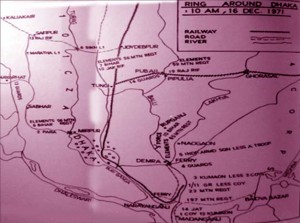 On December 13, Lt. Gen. Sagat Singh had switched 301 Mountain Brigade/23 Mountain Div from Chandpur to Daudkandi due to the availability of river crossing boats there and by December 15, assisted by heli-lift, the Brigade concentrated near Baidya Bazar. It stormed across the Sitalakhya River on the morning of December 16 and started probing Dacca proper from the East, till news of Pakistan’s decision to surrender was received by noon. Thus, Sagat Singh had succeeded in moving 73 and 311 Mountain Brigades to the Northeast of Dacca and 301 Mountain Brigade to the East of Dacca by December 16, besides 93 Mountain Brigade and FJ Sector forces which had reached North of Dacca, to unleash the final assault on Dacca from December 17 onwards had Niazi not agreed to the unconditional surrender.
On December 13, Lt. Gen. Sagat Singh had switched 301 Mountain Brigade/23 Mountain Div from Chandpur to Daudkandi due to the availability of river crossing boats there and by December 15, assisted by heli-lift, the Brigade concentrated near Baidya Bazar. It stormed across the Sitalakhya River on the morning of December 16 and started probing Dacca proper from the East, till news of Pakistan’s decision to surrender was received by noon. Thus, Sagat Singh had succeeded in moving 73 and 311 Mountain Brigades to the Northeast of Dacca and 301 Mountain Brigade to the East of Dacca by December 16, besides 93 Mountain Brigade and FJ Sector forces which had reached North of Dacca, to unleash the final assault on Dacca from December 17 onwards had Niazi not agreed to the unconditional surrender.
This was a great feat of arms for any Field Commander practicing ‘Deep Operations Theory’ and overcoming obstacles-ridden country over a distance of 150-200 km. His menacing manoeuvres caused a ‘freeze mentality’ to set in amongst senior Pakistani commanders in the Eastern Theatre, leading to near complete breakdown of Pakistani morale and the ‘will to fight’. The crossing of the River Meghna which is over 4,000 feet wide at its narrowest stretch, from December 09-10 onwards, without a bridge being available, was a game-changer which ultimately led to the liberation of Bangladesh.
4 Corps under Lt. Gen. Sagat Singh restored the pride of Indian Army after the disaster of the 1962 India-China War and the stalemated 1965 India-Pakistan Conflict, when the aggressors had got away scot-free. As a tribute to him, Lt Gen JS Aurora first went to Agartala by helicopter to pick him and his Divisional Commanders before landing at Dacca for the surrender ceremony, which thereby got delayed. From the Pakistani side, General Aurora was given the ‘Guard of Honour’ by 2 Commando Battalion (later renamed SSG) led by their Commanding Officer. The surrender ceremony was witnessed by the troops of 2 PARA and 6 BIHAR (FJ Sector/101 Communication Zone), 13 GUARDS (95 Mountain Brigade/101 Communication Zone), 4 GUARDS (311 Mountain Brigade/ 57 Mountain Div) and 5 (I) Armoured Squadron (63 CAV and 311 Mountain Brigade/ 57 Mountain Div. It can be said in passing, that Lt. Gen. Sagat Singh became the undisputed “Duke of Wellington” of India.
Conclusion
The need to understand the mechanics of conduct of ‘Deep Operations’ is paramount while undertaking offensive operations. “Limited War” and “Limited Objectives” are mindsets of the mediocre who have not grasped the essence of Major Staff Duties which is to be innovative, gather momentum and be unpredictable after operations commence and not get tied down in predictive methodologies. No War is ever fought and won with adequate resources. However, the fact that India’s Eastern Army Command went to war without possessing an Independent Armoured Brigade and an Independent Amphibious Brigade in its ORBAT stood out as glaring failings. The purpose of doing such an ‘unsparing’ study of the Bangladesh War operations is to drive home the point that if we have to fight the next War, our higher commanders should not be found wanting in the skills needed to undertake ‘Deep Operations’.
References
- The India – Pakistan War of 1971, A History; S N Prasad & U P Thapliyal; Natraj Publishers, Dehradun, 2014.
- Surrender at Dacca – Birth of a Nation; Lt Gen J F R Jacob (Retd); Manohar Publishers, New Delhi, 1997.
- The Betrayal of East Pakistan; Lt Gen A A K Niazi (Retd); Oxford University Press, Karachi, 1998.
- The Liberation of Bangladesh; Maj Gen Sukhwant Singh (Retd); Lancer Publishers, New Delhi, 1980.
- Victory in Bangladesh; Maj Gen Lachman Singh (Retd); Natraj Publishers, Dehradun, 1981.




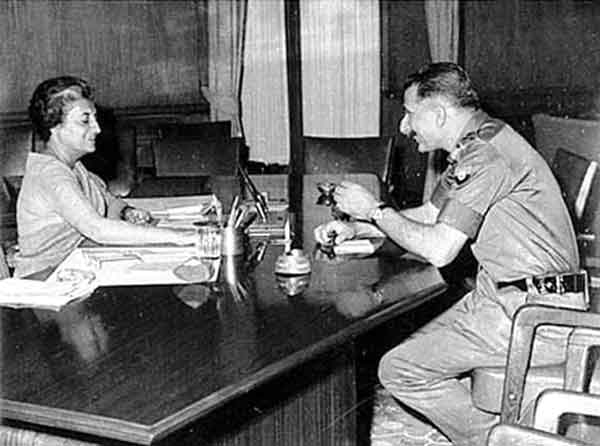
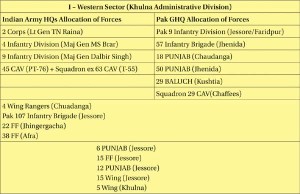
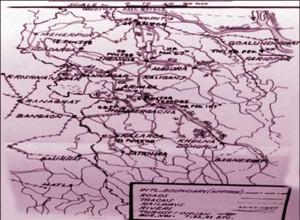

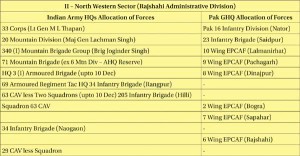
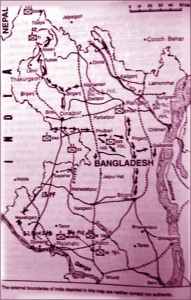
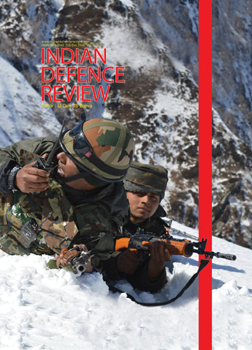


Sir, you may like to correct a major mistake, I take it it must be a typing error, it’s 2 Para which entered Dhacca first and NOT 4 Para. Ref third paragraph of Conduct of Operations.
Regards
A great piece for future students